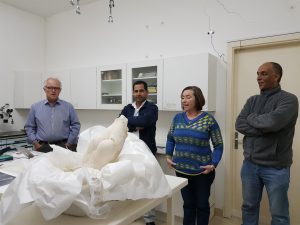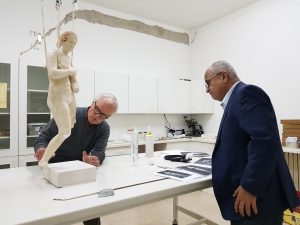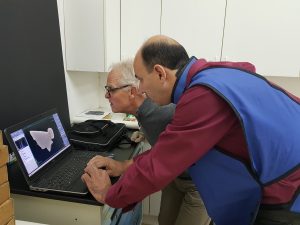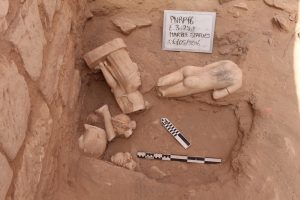
MIGHTY APHRODITE: CONSERVATION AND RESTORATION OF THE PETRA NORTH RIDGE APHRODITE STATUES
Dr. Megan Perry, 2018 Harris Fellowship Recipient
My mentor Patricia Bikai had always warned me that artifacts uncovered during excavation (in her case, carbonized Greek scrolls and mosaic floors of the Petra Church) may require more time and
funds than the excavation itself. ASOR’s Harris Excavation Fellowship allows excavations to include experts whose skills may not have been anticipated during the planning stages of the project to address these unexpected finds.
This came to light in the last hour of a typical excavation day of the 2016 season of the Petra North Ridge Project. My co-director of the excavation, S. Thomas Parker, was in Aqaba meeting with officials regarding preservation of his previous excavation site. I was checking on progress in the 1st – 4th century A.D. domestic structure on the south side of the slope when a staff member called in a sing-song voice from the top of the ridge: “oh, Megan….we have something for you…”

Michael Morris (on left) consulting with (L-R) Ibrahim Masha’aleh (Petra Museum Manager), Khairieh ‘Amr (Petra Museum consultant) and Qais Twaissi (Petra Archaeological Park/Petra Development and Tourism Regional Authority) about the disposition of the statues in the new Petra Museum, with one of the PNRP statues under restoration in the foreground (photograph by Barbara Porter, ACOR.)
I climbed up to Area E, a large complex that we now hypothesize is a villa urbana with its own private bath, to find our staff and students gathered at the western-most trench. “What is it?” I asked as I approached the crowd. “A butt!” proclaimed Sophie Tews, supervisor of Area E, and John Rucker, supervisor of the square. I looked down and, indeed, there was a pair of bulbous, smooth, white buttocks protruding from the reddish sand.
For the next three hours, long after the staff and students in other areas went back to their homes and the dig house in nearby Umm Seihoun, we carefully excavated the broken but almost completely reconstructable parts of two statues of the goddess Aphrodite and her companion Eros. These exquisite pieces could be identified as Knidia-type and even contained remnants of paint. Preliminary analysis of the history and polychromy of the statues by Dr. Mark Abbe, Assistant Professor of Art History indeed revealed multiple hues of pink, red, blue, and even gilding that had decorated the 1st through 3rd century A.D. statues, which he concluded were imported to Petra. Although these statues were not found in their original context, they will illuminate the syncretic nature of Nabataean culture and religion at the outer borders of the Classical world, where the indigenous and traditionally aniconic Arabian goddess of Al-‘Uzzá merged with more familiar naturalistic images of the Greek goddess Aphrodite. Only a few sculptural representations of Aphrodite in a clear Greco-Roman style have been recovered from Petra, including a head possibly dating to the 1st century A.D. found in the ruins of the colonnaded street.
The primary concern after excavation, however, was the condition of the statues. Not only did they need to be reconstructed, but iron and bronze pins used in multiple episodes of ancient repair were

Mr. Morris demonstrating to H.E. Dr. Abdelelah al Khatib (ACOR Board) the preferred stance for museum display of one of the PNRP statues (photograph by Barbara Porter, ACOR.)
corroding and causing the marble to crack and fracture. We also wanted this work to be undertaken in Jordan with the consultation of Jordanian scholars and conservation and museum experts. Dr. Abbe recommended that this stage be left to deft hands of the conservator Michael Morris, an expert in marble architecture and sculpture conservation in both archaeological and museum contexts. The Harris Fellowship provided the funds for Mr. Morris’ initial visit to the American Center of Oriental Research in Amman, Jordan, to assess the statues and begin conservation measures and prepare for a return trip to complete conservation, restoration, and mounting the statues for museum display.
Michael Morris traveled to Amman in July, 2018, and after travel delays, spent an intensive two days examining the statues and outlining his needs for his return trip, including a hoist system to position one of the statues in its proper stance for mounting. One major concern he had the level of humidity in ACOR’s conservation lab, which is located in its lowest level and is the conservation lab and storage area for the metal finds. The humidity levels in both labs were felt to be very high and potentially damaging to the ancient metals filled with salts from burial. We recommended the purchase of temperature and relative humidity monitors and dehumidifiers to reduce the humidity level below 50% (aiming for 40%) to slow the corrosion of the pins and mitigate any damage to the metal objects in storage.
It was critical to assess whether the lab and facilities were adequate for conservation, and to determine what materials were available locally. After the visit it became clear that most of the materials were out of date or for specific purposes other than sculpture conservation and that new materials would need to be purchased and brought to ACOR.

Mr. Morris and radiologist Mohammad Ammar studying an x-ray of one Aphrodite head with a pin in the back in need of conservation (photograph by Barbara Porter, ACOR.)
Mr. Morris also had the chance to meet with officials from under-construction Petra Museum, the likely home for the statues after completion of conservation and mounting and to make a plan for the new installation of the two Aphrodites.
Thus, the Harris Fellowship funded a fundamental step in the conservation, preservation, and mounting of these statues. Undertaking this process in Jordan was a deliberate choice by the project co-directors, which allowed the involvement of Jordanian conservators, museum administrators, and scholars of marble statuary from the Jordan Museum, the Department of Antiquities, local universities, and the new Petra Museum under construction in Wadi Musa.
Dr. Megan Perry is a Professor of Anthropology at East Carolina University and co-director of the Petra North Ridge Project. Her research primarily focuses on the actual remains of people living in the past, not artistic renderings carved in marble, but she has greatly enjoyed learning new applications of archaeological science in this project!

